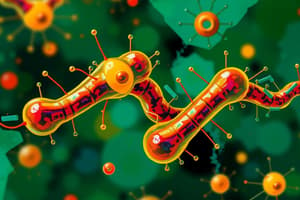Podcast
Questions and Answers
Both rosiglitazone and pioglitazone are rapidly absorbed and have a peak concentration of less than 2 hours.
Both rosiglitazone and pioglitazone are rapidly absorbed and have a peak concentration of less than 2 hours.
True (A)
The elimination half-life of rosiglitazone and pioglitazone is longer than 7 hours.
The elimination half-life of rosiglitazone and pioglitazone is longer than 7 hours.
False (B)
Bile acid sequestrants are primarily used as antihypertensive agents.
Bile acid sequestrants are primarily used as antihypertensive agents.
False (B)
GLP-1 receptor agonists amplify insulin secretion in a glucose-dependent manner.
GLP-1 receptor agonists amplify insulin secretion in a glucose-dependent manner.
Dipeptidyl peptidase-4 (DPP-4) inhibitors include drugs like metformin and glipizide.
Dipeptidyl peptidase-4 (DPP-4) inhibitors include drugs like metformin and glipizide.
Colesevelam is a type of GLP-1 receptor agonist.
Colesevelam is a type of GLP-1 receptor agonist.
Weight gain is a common side effect associated with the use of rosiglitazone and pioglitazone.
Weight gain is a common side effect associated with the use of rosiglitazone and pioglitazone.
GLP-1 receptor agonists can lead to an increase in appetite.
GLP-1 receptor agonists can lead to an increase in appetite.
The mechanism of action for DPP-4 inhibitors includes reducing glucagon levels.
The mechanism of action for DPP-4 inhibitors includes reducing glucagon levels.
Sitagliptin is an example of a bile acid sequestrant.
Sitagliptin is an example of a bile acid sequestrant.
Study Notes
Diabetes Mellitus Overview
- Chronic metabolic disorder leading to hyperglycemia.
- Caused by defects in insulin secretion or action affecting carbohydrate, fat, and protein metabolism.
Classification of Diabetes Mellitus
- Type 1 DM: Insulin-dependent; requires insulin for survival due to absence of insulin.
- Type 2 DM: Non-insulin dependent; insulin is present but ineffective due to:
- Insulin resistance in cells.
- Secretory defects in insulin production.
- Gestational Diabetes Mellitus: Occurs during pregnancy, often resolves postpartum.
- Other Specific Types:
- MODY (Maturity Onset Diabetes of the Young) types 1-6.
- Fibrocystic pancreatic diabetes (drug-induced by thiazides, diuretics, steroids).
- Endocrinopathies (e.g., acromegaly, Cushing syndrome).
Clinical Significance
- Common Symptoms:
- Polyuria (increased urination).
- Polydipsia (increased thirst).
- Polyphagia (increased hunger).
- Weight loss.
- Blurred vision.
- Tingling or burning sensations.
- Recurrent infections (e.g., boils).
Diagnosis Criteria
- Fasting plasma glucose ≥ 7.0 mmol/L (126 mg/dL) indicates diabetes.
- Random plasma glucose ≥ 11.1 mmol/L (200 mg/dL) confirms diabetes.
- Symptomatic individuals require one abnormal lab value; asymptomatic individuals require two.
Management Strategies
- Key Components:
- Patient education.
- Dietary modifications.
- Drug therapy.
- Rehabilitation services.
Drug Therapy Insights
- Type 1 DM: Requires insulin for survival.
- Insulin Structure: Small protein, molecular weight of 5808 Da, composed of 51 amino acids in two chains linked via disulfide bridges.
- Side Effects of Insulin: Weight gain, gastrointestinal disturbances, allergic reactions, bone marrow damage.
Drug Interactions Enhancing Hypoglycemia
- NSAIDs, Coumarins, Alcohol, Sulfonamides, Primethoprim, Chloramphenicol, Imidazoles, Antifungal agents.
Sulfonylureas
- First Generation: Tolbutamide, Chlorpropamide, Tolazamide.
- Second Generation: Glyburide, Glipizide, Glimepiride; offer fewer adverse effects and interactions.
Biguanides
- Examples: Metformin, Phenformin (discontinued due to lactic acidosis risk).
- Mechanism of Action:
- Increases glucose removal from blood.
- Decreases hepatic gluconeogenesis.
- Slows glucose absorption from the gastrointestinal tract.
- Reduces plasma glucagon levels.
- Metformin Characteristics: Half-life of 1.5-3 hours, kidney-excreted, no protein binding.
- Contraindications: Renal or hepatic disease, pulmonary disease, heart failure.
Thiazolidinediones (Glitazones)
- Mechanism: Activates PPAR-gamma nuclear receptor, enhancing insulin sensitivity in adipose tissue, muscle, and liver.
- Pharmacokinetics: Rapid absorption, reaches peak in < 2 hours, liver metabolized, elimination half-life < 7 hours.
- Side Effects: Weight gain, fluid retention, headache, fatigue, potential hepatotoxicity.
Bile Acid Sequestrants
- Example: Colesevelam.
- Mechanism: Affects enterohepatic circulation, decreases fornesoid X receptor activation.
GLP-1 Receptor Agonists
- Function: Amplifies glucose-dependent insulin secretion, inhibits glucagon release, reduces appetite.
- Examples: Exenatide, Liraglutide.
Dipeptidyl Peptidase-4 (DPP-4) Inhibitors
- Examples: Sitagliptin, Saxagliptin, Linagliptin.
- Action: Elevates levels of natural GLP-1, enhances insulin secretion, lowers glucagon levels.
Studying That Suits You
Use AI to generate personalized quizzes and flashcards to suit your learning preferences.
Related Documents
Description
This quiz provides an overview of Diabetes Mellitus, a chronic metabolic disorder characterized by hyperglycemia. It covers the classification of diabetes types, including Type 1, Type 2, and Gestational Diabetes, along with common symptoms and clinical significance of the condition.




